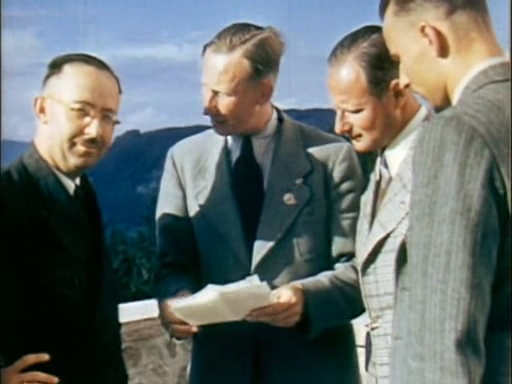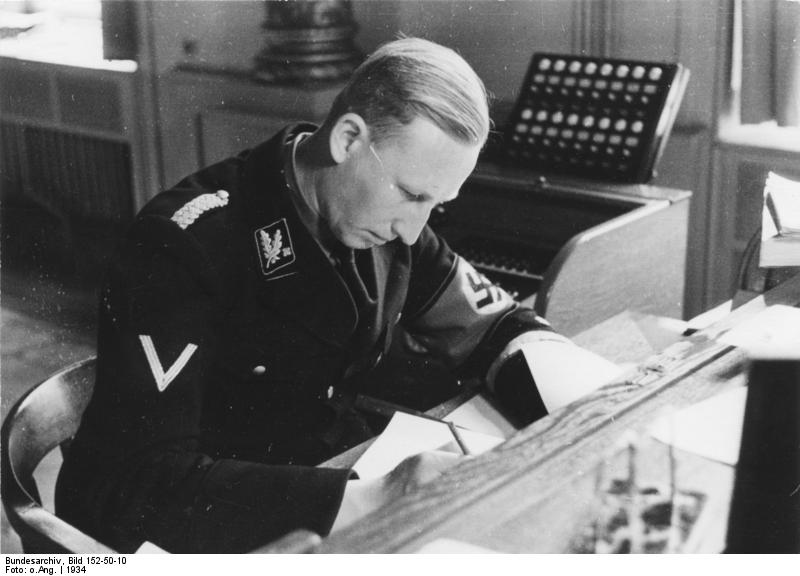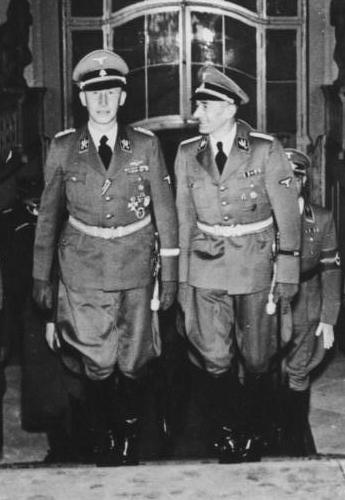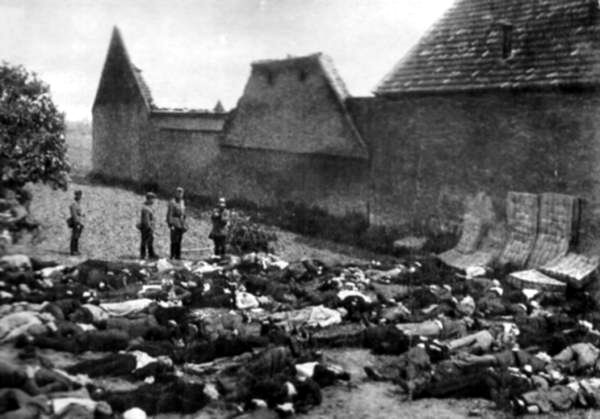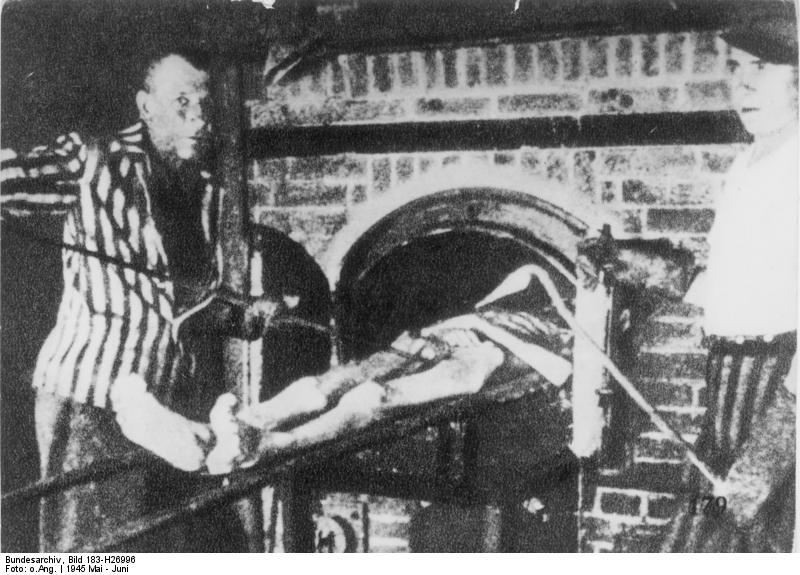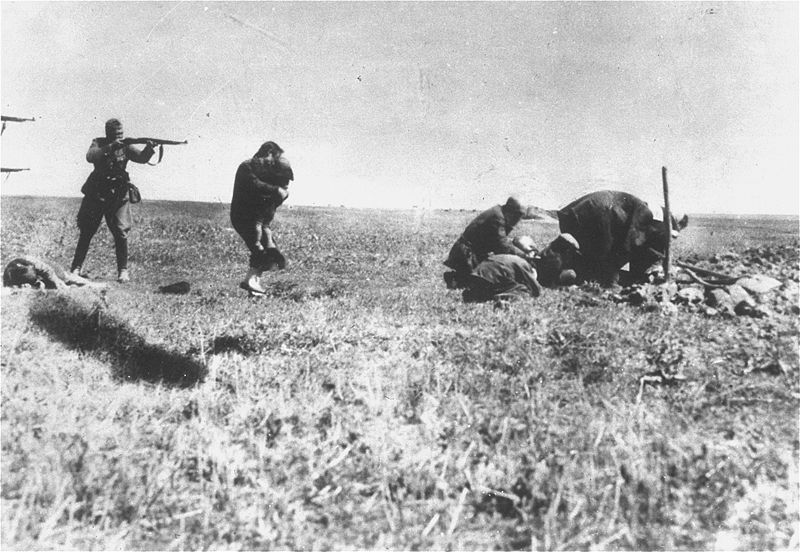<Back to Index>
- Physicist Antoine César Becquerel, 1788
- Architect and Painter Baldassare Tommaso Peruzzi, 1481
- Director of the Reich Main Security Office Reinhard Tristan Eugen Heydrich, 1904
PAGE SPONSOR
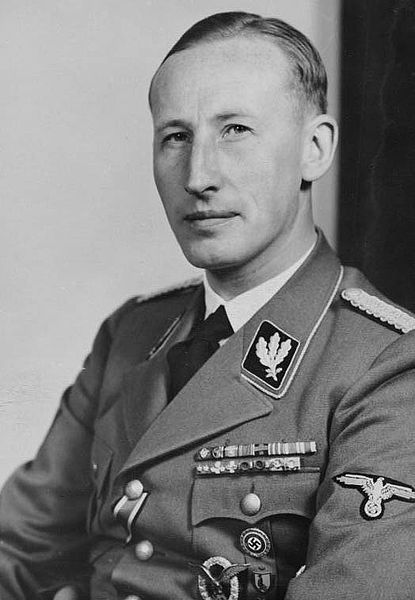
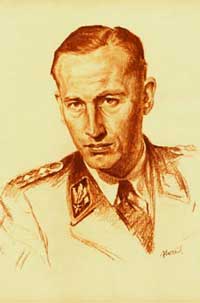
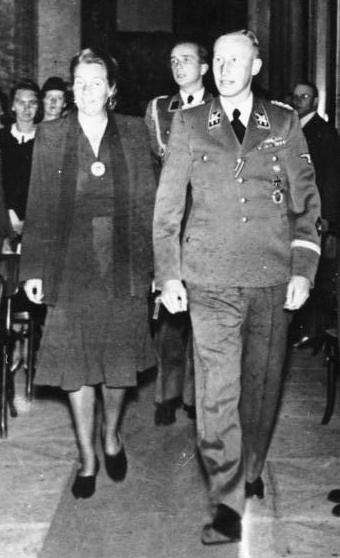
Reinhard Tristan Eugen Heydrich (7 March 1904 – 4 June 1942) was a high ranking German Nazi official. He was SS - Obergruppenführer (General) and General der Polizei, chief of the Reich Main Security Office (including the SD, Gestapo and Kripo) and Stellvertretender Reichsprotektor (Deputy Reich - Protector) of Bohemia and Moravia. In August 1940, he was appointed and served as President of Interpol (the international law enforcement agency). Heydrich chaired the 1942 Wannsee Conference, which discussed plans for the deportation and extermination of all Jews in German occupied territory. He was attacked by British trained Czech agents on 27 May 1942 sent to assassinate him in Prague (Operation Anthropoid). He died approximately one week later due to his injuries.
Heydrich was born in Halle an der Saale to composer Richard Bruno Heydrich and his wife Elisabeth Anna Maria Amalia Kranz. Her father was Hofrat Kranz, founder of the Dresden Conservatory. Reinhard's two forenames were patriotic musical references: "Reinhard" from Amen, an opera written by his father, in a portion called "Reinhard's Crime", while his first middle name, 'Tristan' stems from Richard Wagner's Tristan und Isolde. His third name probably derives from military hero Prince Eugene of Savoy. He was born into a well-to-do Catholic family. Music was a part of Heydrich's everyday life; his father was an opera singer as well as the founder of the Halle Conservatory of Music. Young Heydrich developed a passion for the violin, which he carried into his adult life, and he impressed listeners with his musical talent.
His father was a German nationalist who instilled patriotic ideas in the minds of his three children. The Heydrich household was very strict and the children were frequently disciplined when needed. As a youth, Heydrich engaged his younger brother, Heinz, in mock fencing duels, thus developing strong fencing skills. Heydrich was very intelligent and excelled in his schoolwork at the Reform - Realgymnasium. He was a talented athlete and he became an expert swimmer and fencer. However, he was shy, insecure and frequently bullied for his high pitched voice and his family's Catholicism (the community was at the time largely Protestant). It was also rumored that he had some Jewish ancestry — his grandmother's second husband had a Jewish sounding surname — and these rumours were later used by Heydrich's superiors in the Nazi Party to exercise a measure of control over him.
When World War I broke
out in 1914, 10 year old Heydrich was too young to enlist for military
service. He joined Maercker's Volunteer Rifles [the first Freikorps unit to be formed under Defence Minister Gustav Noske's directives], a right wing paramilitary group that strongly opposed the Communists. He also joined the Deutschvölkischer Schutz und Trutzbund, (The National German Protection and Shelter League), an anti-Semitic organisation. In 1918, the war ended with Germany's defeat. Because of the conditions of the Treaty of Versailles, inflation spread across Germany and many families — including Heydrich's — lost their life savings. In 1922, he joined the Navy, taking advantage of the education and pension it offered. He became a naval cadet at Germany's chief naval base at Kiel.
Heydrich was unpopular among his fellow cadets, however, as rumours of
his supposed Jewish ancestry resurfaced. In 1926, he advanced to the
rank of ensign (Leutnant zur See) and was assigned as a signals officer
on the battleship Schleswig Holstein.
Finding himself with authority over the subordinate officers who had
once bullied him, he got revenge by treating them like lowly subjects. Heydrich became a notorious womanizer, having countless affairs. One night in 1930, he attended a rowing club ball and met Lina von Osten. The two became romantically involved and soon announced their engagement. A former lover, the daughter of a shipyard director, became infuriated that Heydrich was going to marry another woman, and
she then complained to her father, a friend of Admiral Erich Raeder,
then Chief Of Naval Operations. A formal complaint was lodged against
Heydrich for insulting the honor of a young woman. He was charged with
"conduct unbecoming to an officer and a gentleman" and an investigation
ensued. Heydrich was called before a court of honour and he protested
his innocence, accusing the woman of lying. Though he was exonerated,
the officers demanded that he be cashiered for "conduct unbecoming a
naval officer". In April 1931, Raeder sentenced Heydrich to "dismissal
for impropriety." He was dismissed in 1931. Heydrich was devastated, but he remained engaged to Lina von Osten. He now found himself with no prospects for a career. In 1931, Heinrich Himmler began to set up a counter intelligence division of the SS. Acting on the advice of his associate Karl von Eberstein, who was a friend of Lina von Osten, Himmler interviewed Heydrich. A
commonly stated version is that Himmler arranged for an interview with
Heydrich and was instantly impressed, hiring him on the spot. His pay
was 180 reichsmarks per month (40 USD). In doing so Himmler also effectively recruited Heydrich into the Nazi Party. He would later receive a Totenkopfring from Himmler for his service. To begin work, Heydrich set up his office at the Brown House, the Nazi Party headquarters in Munich.
He set about creating a counter intelligence service to be reckoned
with. At this time, he was insignificant within the Nazi Party
apparatus. Heydrich created his own network of spies and informers and dispatched them to obtain information to be used as blackmail, pursuing the party's opponents as well as high ranking Nazis themselves. In
December 1931, Heydrich and von Osten married. That same year, he was
promoted to SS major. As early as 1931, Heydrich was becoming one of
the most dangerous men in the Nazi Party. With his vast archive of
cross referenced index cards, the fate of Nazi opponents rested upon
his whims. In 1932, however, Heydrich was given a taste of his own medicine by Adolf Hitler.
A number of Heydrich's enemies had discovered the old rumours of his
possible Jewish ancestry and began to spread them around. Within the
Nazis' organisation such innuendo could be deadly, even for the head of
the Reich's counter intelligence service. An investigation was conducted by Nazi Party racial expert Dr. Achim Gercke into Heydrich's genealogy. Dr Gercke reported that Heydrich was "... of German origin and free from any coloured and Jewish blood". Nevertheless,
Himmler was distressed by the mere suggestion of a man with "tainted"
blood heading his counter intelligence service. In 1942 Himmler told Felix Kersten,
his personal masseur, that he had discussed the matter ten years
earlier with Hitler, back when Himmler was head of the Bavarian
political police. Hitler then interviewed Heydrich and found him "a
highly gifted but also very dangerous man, whose gifts the movement had
to retain". Himmler
related to Kersten that Hitler said Heydrich's "non-Aryan origins were
extremely useful; for he would be eternally grateful to us that we had
kept him and not expelled him and would obey blindly". Himmler said to Kersten that Hitler's appraisal turned out to be accurate — that he did obey blindly. However,
Kersten's recollection of this event and the actions described
involving Himmler and Hitler are "somewhat suspect", having been
challenged by historian Max Williams, who holds it should be "viewed
with caution". In
July 1932, Heydrich's counterintelligence service grew into an
effective machine of terror and intimidation. With Hitler agitating for absolute power in
Germany, Himmler and Heydrich wished to control the political police
forces of all 17 German states, and they began with the state of Bavaria.
In 1933, Heydrich gathered some of his men from the SD and together
they stormed police headquarters in Munich and took over the police
using intimidation tactics. Himmler became commander of the Bavarian
political police with Heydrich as his deputy. From there, the duo moved
on to the police forces of the 16 remaining German states. With 15
states under their control, they locked horns with Hermann Göring as to Prussia. Göring
controlled the Prussian political police, and he disliked both Himmler
and Heydrich. Göring's intentions were that his police force would
stand apart from any other police organization and that its officers
would obey no laws, they would be a law unto themselves. He named his
organisation GEheime STAatsPOlizei (GESTAPO, Secret State Police).
For the purpose of a franking stamp, a postal clerk abbreviated the
name to Gestapo. Göring wanted to transfer them out of police
headquarters and give them their own command centre. In 1933, Hitler became Chancellor of Germany, but he still did not have the dictatorial powers that he desired. In order to give himself more power, he pressured President Paul von Hindenburg to sign a series of decrees which would hamper opposition parties such as the Communists and Socialists.
With these decrees, the police had the authority to conduct searches,
confiscate property, and arrest and detain people without allowing
either a hearing or a trial. Heydrich consulted his list of index cards
and supplied the SS and the brown shirted SA (Sturmabteilung)
with lists containing the names of "offenders" to be arrested. Since
Heydrich's index cards numbered in the thousands, the prisons were soon
filled beyond capacity and the first concentration camps were established to deal with the overflow of prisoners. On
20 April 1934, Göring and Himmler agreed to put aside their
differences (largely because of their shared hatred and growing dread
of the Sturmabteilung). Göring transferred full authority over the
Gestapo to Himmler, who was also named chief of all German police
forces outside of Prussia. Himmler on 22 April 1934 named Heydrich the
head of the Gestapo. With the Gestapo under their control, the two men plotted its use along with the SS to crush the SA. Heydrich had his men uncover false "evidence" that SA leader Ernst Röhm was plotting to overthrow Hitler. Himmler put pressure on Hitler to purge Röhm and the leading members of the SA. Meanwhile Heydrich, Himmler, Göring, and Lutze (at Hitler's direction) drew up lists of those who should be "liquidated" starting
with seven top SA officials and ending with many more. On 30 June 1934,
the SS and Gestapo acted in coordinated mass arrests that continued
throughout the entire weekend. Röhm was shot (without trial) along
with the leadership of the SA. This Nazi purge became known as the Night of the Long Knives. With
the SA out of the way, Heydrich began building the Gestapo into an
instrument of fear. He improved his index card system. Since he created
more categories of offenders, the cards were now colour coded. The
Gestapo had the authority to arrest citizens on the mere suspicion that
they might commit
a crime, and the definition of a crime was at their discretion; Hitler
himself said of the agency that "all means, even if they are not in
conformity with existing laws and precedents, are permitted if they
serve the will of the Führer". People
began disappearing throughout Germany, never to be seen again. At a
later date, their families would receive an urn containing their ashes.
Under Himmler and Heydrich, Germany became a police state.
Further, Himmler had been involved in developing his idea of a
"Germanic religion" and wanted SS members to leave the church. In the
spring of 1936, Heydrich left the Catholic Church. His wife, Lina, had
already left the church the year before. Heydrich not only felt he
could no longer be a member, but came to consider the political power
(and influence) of the church a danger to the state. On
17 June 1936, all police forces throughout Germany were united with
Himmler as the chief. On 26 June, Himmler reorganised the police into
two groups: Ordnungspolizei (Orpo), which consisted of the national uniformed police and the municipal police, and Sicherheitspolizei (SiPo), which consisted of the Gestapo and the Kripo or Kriminalpolizei (Criminal Police). At that point, Reinhard Heydrich was head of the SiPo, Gestapo, Kripo and SD. Heinrich Müller, was the chief of operations of the Gestapo. Heydrich's first task was the suppression of all possible dissent prior to and during the 1936 Olympics,
a task he executed with a cold and systematic ruthlessness that gained
him the German Olympia Honour Badge (First Class) (Deutsches
Olympiaehrenzeichen). In
September 1939, the SD, and SiPo (made up of the Gestapo and the Kripo)
were unified under one office, the Reich Main Security Office or RSHA,
which was placed under Heydrich's control. At that time, the title of
"Chef der Sicherheitspolizei und des SD" (Chief of the Security Police
and SD) or CSSD was conferred on Heydrich. On 24 August 1940, Heydrich also became the President of Interpol. Thereafter, the headquarters of Interpol was transferred to Berlin. He was promoted to SS-Obergruppenführer und General der Polizei on 24 September 1941.
In 1936, the SD received information that a top ranking Soviet officer was plotting to overthrow Joseph Stalin. Sensing an opportunity to strike a blow at both the Soviet Army as well as Admiral Canaris of the German Abwehr, Heydrich decided the Russian officers should be "unmasked". Heydrich
discussed the matter with Himmler and both in turn brought it to the
attention of Hitler. Unknown to Heydrich, the "information" that he
received about the officers plot was actually initiated by Stalin
himself in an attempt to make his purges of the Red Army high command
believable. Stalin ordered one of his best NKVD agents, General Nikolai Skoblin, to pass Heydrich the false information suggesting a plot against Stalin by Marshall Mikhail Tukhachevsky and
other Soviet generals. Heydrich received approval from Hitler to act
immediately on the information. Heydrich's SD forged a series of
documents and correspondence implicating Tukhachevsky and other Red
Army commanders. The material was delivered to the NKVD. The Great Purge of the Red Army followed
upon orders of Stalin. While Heydrich believed they had successfully
deluded Stalin into executing or dismissing some 35,000 of his officer
corps, the importance of Heydrich's part is a matter of speculation and
conjecture. It
is notable that the forged documents were not even used by Soviet
military prosecutors against the generals in their secret trial,
instead relying on false confessions extorted or beaten out of the
defendants. The purge significantly impaired the combat capabilities of the Red Army for some time.
By late 1940, Hitler's armies had swept through most of Western Europe. To Hitler's dismay, anti-Nazi resistance was alive and well, especially in Norway, France, the Netherlands and Belgium. In 1941, the SD was given the responsibility of carrying out the Nacht und Nebel (Night
and Fog) decree, designed to crush this resistance. According to the
decree, suspects had to be arrested in a maximally discreet way "under
the cover of night and fog". People simply disappeared without a trace
and no one was told of their whereabouts or their eventual fate. For
each prisoner, the SD was required to fill out a questionnaire that
listed their personal information, their country of origin and the
details of their crimes against the Reich. This questionnaire was to be
put into an envelope inscribed with a seal that read "Nacht und Nebel"
and submitted to the Reich Main Security Office (RSHA). In the WVHA "Central
Inmate File", as in many camp files, these prisoners would be given a
special "covert prisoner" code, as opposed to the code for POW, Felon,
Jew, Gypsy, etc. This
decree remained in effect after Heydrich's death. The exact number of
people who vanished in the name of the decree has never been positively
established, but it is estimated to be roughly 7,000. On 27 September 1941 Heydrich was appointed Stellvertretender Reichsprotektor in the Protectorate of Bohemia and Moravia (the part of Czechoslovakia incorporated
into the Reich on 15 March 1939 and assumed effective government of the
territory, as Hitler, Himmler and Heydrich felt Konstantin von Neurath,
(Heydrich's predecessor) "soft approach" to the Czechs promoted
anti-German sentiment, and encouraged anti-German resistance by strikes
and sabotage. Heydrich came to Prague to
"strengthen policy, carry out counter measures against resistance" and
keep up production quotas of Czech motor and arms that were "extremely
important to the German war effort". As the governor of Bohemia and Moravia, Heydrich applied "carrot-and-stick" methods. The black market was suppressed, food rations and pensions were increased, and unemployment insurance was established for the first time. Those associated with the resistance movement or the black market were tortured or executed.
His use of terms to describe those harshly dealt with as "economic
criminals" and "enemies of the people" in the Press, helped gain him
support. Under Heydrich, conditions in Prague and the rest of the Czech
lands were relatively peaceful and industrial output went up. Heydrich
was, for all intents and purposes, military dictator of Bohemia and
Moravia. His changes to the government's structure left President Emil Hacha and
his cabinet virtually powerless. He often drove alone in a car with an
open roof — a show of his confidence in the occupation forces and
in the effectiveness of his government. In
London, the Czechoslovak government in exile (Prozatímní
státní zřízení) was plotting to assassinate
Heydrich. Two men specially trained by the British Special Operations Executive (SOE), Jan Kubiš and Jozef Gabčík,
were chosen for the operation. After receiving training from the
British, they returned by parachute on 28 December 1941, dropped from a Halifax of 138 Squadron RAF.
On
27 May 1942, Heydrich was scheduled to attend a meeting with Hitler in
Berlin. Heydrich would have to pass a section where the Dresden -
Prague road merged with a road to the Troja Bridge. That intersection
was
perfect for the attack because Heydrich's car would have to slow to
negotiate a hairpin turn. The attack was scheduled for 27 May. On that
date, Heydrich was ambushed while he rode in his open car in the Prague
suburb of Libeň. As the car slowed to take the turn, Gabčík took aim with a Sten sub-machine gun,
but it jammed and failed to fire. Instead of ordering his driver to
speed away, Heydrich called his car to a halt in an attempt to take on
the attackers. Kubiš then threw a bomb (a converted anti-tank mine) at
the rear of the car. The explosion wounded Heydrich and also Kubiš himself. It
is alleged that when the smoke cleared, Heydrich emerged from the
wreckage with his gun still in his hand and he gave chase after Kubiš
and tried to return fire. At least one account states that his pistol
was not loaded. He ran for half a block, became weak from shock,
and sent his driver, Klein, on foot to chase Gabčík. In the
ensuing firefight, Gabčík shot Klein in the leg and escaped. Heydrich appeared not to be seriously injured. One
version suggests that a Czech woman went to Heydrich's aid and flagged
down a truck delivering floor polish. First, Heydrich was placed in the
back seat, but after complaining that the movement of the truck was
causing him pain, he was placed in the back of the truck, lying on his
stomach, and he was taken to Bulovka hospital. He had suffered a severe
injury to the left side of his body with major damage to his diaphragm, spleen, and lung,
as well as a broken rib. The doctors immediately performed an operation
and, despite a slight fever, his recovery appeared to progress well. On
2 June, during a visit with Himmler, Heydrich reconciled himself with
his fate by reciting a part of one of his father's operas: "The
world is just a barrel-organ which the Lord God turns Himself. We all
have to dance to the tune which is already on the drum." After Himmler's visit, Heydrich slipped into a coma and never regained consciousness. He died on the 4th of June, probably around 4:30am, at the age of 38. The autopsy states that he died of septicemia.
Of peculiar note, Heydrich's facial expression as he died (his "death
mask") betrayed an "uncanny spirituality and entirely perverted beauty,
like a renaissance Cardinal," according to Dr. Bernhard Wehner, a
police official who investigated the assassination. Hitler
was enraged that his "protector" of Czechoslovakia had been
assassinated, and ordered a quick investigation. Intelligence linked the assassins to the town of Lidice, Czechoslovakia, and Ležáky.
In retaliation, Hitler ordered a series of deportations and executions
in Lidice, including the execution of all male residents over 16. The
town was later completely eradicated - demolished and burned to the
ground, even the graveyard was excavated, the remains therein
destroyed. Children who had blond hair and blue eyes were separated
from their families and "adopted" by German families. A similar punishment was also carried out soon after at the village of Ležáky.
Heydrich was buried in Berlin's Invalidenfriedhof,
a military cemetery. The location of the grave in the Invalidenfriedhof
is not entirely certain. Heydrich's plot may be between those of two
famous German war heroes, Adolf Karl von Oven and Gerhard von Scharnhorst (cemetery section C). Hitler
wanted Heydrich to have a monumental tomb, but because of the downhill
course of the war the tomb was never built. In 1945 Heydrich's
temporary wooden grave marker disappeared. The marker was never
replaced, because the Allies and Berlin authorities feared Heydrich's grave would become a rallying point for Neo-Nazis, as is the grave of Rudolf Hess in the little Bavarian town of Wunsiedel. When Berlin became a divided city, the cemetery abutted the line between East Berlin and West Berlin, which in the 1960s became the path of the Berlin Wall.
During the time when the Wall was standing, Heydrich's grave may have
been part of the so-called "death strip" between the two Berlins and
inaccessible to the public, though this is unlikely because section C
of the Invalidenfriedhof is in the front of the cemetery, near the
Scharnhorststraße entrance, and the death strip was in the back
(southwest sections E, F, and G and along the Schiffahrtskanal). A
letter published in the Frankfurter Allgemeine Zeitung in
1992 asserted that Heydrich's grave is in cemetery section A next to
General of Infantry Count Tauentzien von Wittenberg, who fought against Napoleon in the wars of liberation (1813). A recent biography of Heydrich also places the grave in Section A. A
photograph of Heydrich's burial shows the wreaths and mourners to be in
section A, which abuts the north wall of the Invalidenfriedhof and
Scharnhorststraße at the front of the cemetery. Infuriated, Hitler ordered the arrest and execution of 10,000 randomly selected Czechs, but, after consultations with Karl Hermann Frank, he reduced his response. Upon Himmler's orders, the Nazi retaliation was brutal. About 13,000 people were arrested, deported, imprisoned or killed. On 10 June, all males over the age of 16 in the village of Lidice, 22 km north-west of Prague, and another village, Ležáky, were murdered. The towns were burned and the ruins leveled. Heydrich's assassins took refuge in the crypt of Ss. Cyril and Methodius Cathedral,
an Orthodox church in Prague. Their location betrayed by two traitors
in the Czech resistance movement, the church was surrounded and the
Germans started firing on it. Rather than surrender, the assassins took
their own lives. Among those tortured and killed was the church's
leader, Bishop Gorazd,
who is now revered as a martyr of the Orthodox Church. There is a
special memorial to both the assassins and the dead of Lidice and
Lezaky in Jephson Gardens, Royal Leamington Spa,
where the Czech forces were stationed during the war, and where their
training took place. The memorial fountain is in the form of a
parachute, with water running over the centre fold. Planted around the
fountain is the special white Lidice Rose, grown in commemoration of
the dead. This memorial is believed to be the only place outside of
Czechoslovakia where the special rose is grown. The fountain was
designed and is maintained by Warwick district council. There are also roses from Lidice at Aston Abbotts in Buckinghamshire. Jan Kubiš and Jozef Gabčík had trained with the British Special Operations Executive at various Special Training Schools in England and Scotland, including STS21 established at Arisaig House, Arisaig near Lochaber in Scotland. An
elaborate funeral was conducted for Heydrich in Prague and Berlin, with
Hitler attending (and placing Heydrich's decorations on his funeral pillow, the highest grade of the German Order and the Blood Order Medal).
Although Heydrich's death was employed as pro-Reich propaganda, Hitler
seemed privately to blame Heydrich for his own death, through
carelessness: Since
it is opportunity which makes not only the thief but also the assassin,
such heroic gestures as driving in an open, unarmoured vehicle or
walking about the streets unguarded are just damned stupidity, which
serves the Fatherland not
one whit. That a man as irreplaceable as Heydrich should expose himself
to unnecessary danger, I can only condemn as stupid and idiotic. Heydrich's eventual replacements were Ernst Kaltenbrunner as the chief of RSHA, and Karl Hermann Frank 27 – 28 May 1942 and Kurt Daluege 28 May 1942 - 14 October 1943 as the new acting Reichsprotektors. After Heydrich's death, his legacy lived on; the first three "trial" death camps were constructed and put into operation at Treblinka, Sobibór, and Belzec. The project was named Operation Reinhard in Heydrich's honor.
As chief of all police forces, Himmler was technically responsible to Wilhelm Frick,
the minister of the Interior, but in practice answered only to Hitler.
Himmler's police forces were independent and they obeyed no government
laws. Rather than protecting the citizens of the Reich, the role of the
police had become that of protecting the Reich from its citizens.
Heydrich's brutal efficiency in this department earned him the
nicknames "the blonde beast" and "Himmler's evil genius". Heydrich
and Himmler had an odd but practical working relationship. Although
Himmler was the boss, Heydrich was the true force behind the SD and
Gestapo. While they personally disliked each other, the
two men formed a solid partnership and became a force to be reckoned
with within the Party. Their thirst for power took them beyond the
periphery of the SD and SS. While
Heydrich's abilities were never doubted by superiors and subordinates
alike, his arrogance and combativeness won him few supporters within
the Party and he occasionally embarrassed Himmler, who had to clean up
the mess. Himmler would occasionally lose his patience with Heydrich, berating and abusing him, sometimes calling him "Genghis Khan". In light of the Blomberg - Fritsch Affair,
Heydrich braced himself for the possibility of Himmler firing him.
Himmler did not fire Heydrich, but he was clearly angered. In a public
speech, Himmler stated that he was misguided by his incapable
subordinates. Although he did not name Heydrich specifically, Heydrich
knew that he was one of them. Upon the establishment of the Third Reich,
Heydrich helped Hitler and Himmler gather information on many political
opponents, keeping an extensive filing system listing individuals and
organizations who opposed the party and the regime. He was believed to
be the creator of the forged documents of Russian correspondence with
the German High Command. While it is now known that the Stalinist Great Purge of the Soviet military officer corps was at most tangentially related to these forgeries,
at the time they were widely believed to have resulted from Heydrich's
actions, enormously adding to his prestige. He was also instrumental in
establishing the false 'attack' by Poland on German national radio at Gleiwitz, intended to provide the Nazi justification for the beginning of World War II.
This fabrication failed, however, and only came to light after the war,
when Allied investigators began researching the captured German documents. Although ultimate responsibility for the Holocaust falls on Adolf Hitler and Heinrich Himmler, Heydrich was one of the main architects of the Holocaust during
the first years of the war, only answering to, and taking orders from
Hitler and Himmler in all matters that pertained to the deportation,
imprisonment, and extermination of Jews. Below are a few referenced
examples describing his involvement. During Kristallnacht,
November 1938, he sent a telegram to various SD and Gestapo offices,
helping to coordinate the program with the SS, SD, Gestapo, uniformed
police (Orpo), Nazi party officials, and even the fire departments. It
talks about permitting arson and destruction of Jewish businesses and
synagogues, and orders the taking of all "archival material" out of
Jewish community centers and synagogues. The telegram also ordered that
"as many Jews -- particularly affluent Jews -- are to be arrested in all districts as can be accommodated in existing detention
facilities... Immediately after the arrests have been carried out, the
appropriate Concentration Camps should be contacted to place the Jews
into camps as quickly as possible." After Kristallnacht, Göring assigned him as head of the Central Office for Jewish Emigration. In this position, he worked tirelessly both to coordinate various initiatives for the Final Solution, and to assert SS dominance over Jewish policy. On 21 September 1939 Heydrich sent out a teletype to the Chiefs of all Einsatzgruppen of the Security Police with
a subject of "Jewish question in the occupied territory". It contained
instructions on how to round up Jewish people for placement into
ghettos, formation of Judenrat, ordering of Census, Aryanization plans for Jewish owned businesses and farms, etc. On
29 November 1939 he sent out another cable regarding the "Evacuation of
New Eastern Provinces", describing various details of the "evacuation"
of people by railway, and giving guidance surrounding the Dec 1939
Census which would be the basis on which those evacuations were formed. In May 1941, Heyrdrich drew up the regulations with the First Quarter-master General Eduard Wagner for the up-coming Operation Barbarossa that ensured that the Einsatzgruppen and Army would co-operate with murdering Soviet Jews. On 10 October 1941, he was the senior officer at a meeting in Prague that discussed evacuating 50,000 Jewish people from the Protectorate of Bohemia and Moravia (mostly in the modern day Czech Republic) to ghettos in Minsk and Riga. Also discussed was the taking of 5,000 Jewish people "in the next few weeks" from Prague and handing them over to the Einsatzgruppen commanders
Nebe and Rasch. The creation of ghettos in the Protectorate was also
discussed, which would eventually result in the construction of Theresienstadt, where 33,000 people would eventually die, and tens of thousands more would pass through on their way to death in the East. Further, in 1941 Himmler named
Heydrich as "responsible for implementing" the forced movement of
60,000 Jewish people from Germany and Czechoslovakia to the Lodz (Litzmannstadt) Ghetto in Poland. Most infamously in this respect, on 20 January 1942, Heydrich chaired the Wannsee Conference,
at which he presented to the heads of a number of German Government
departments a plan for the deportation and transporting of 11 million
Jewish people from every country in Europe to be worked to death or killed outright in the East. "Under
suitable direction, the Jews should be brought to the East in the
course of the Final Solution, for use as labour. In large labour gangs,
with the sexes separated, the Jews capable of work will be transported
to those areas and set to road building, in the course of which,
without doubt, a large part of them ("ein großteil") will fall
away through natural losses. The surviving remnant, surely those with
the greatest powers of resistance, will be given special treatment,
since, if freed, they would constitute the germinal cell for the
re-creation of Jewry." Einsatzgruppen
(German: "task forces", "special-ops units") were paramilitary groups
formed under the direction of Reinhard Heydrich and operated by the
Schutzstaffel (SS) before and during World War II. Their principal task
(during the war), according to SS General Erich von dem Bach - Zelewski,
at the Nuremberg Trials: "was the annihilation of the Jews, Gypsies,
and Soviet political commissars". They were a key component in the
implementation of the "Final Solution of the Jewish question" (German:
Die Endlösung der Judenfrage) in the conquered territories. These
killing units should be viewed in conjunction with the Holocaust. During
the war these units were formed mainly of men from the Ordnungspolizei
(Orpo), the Waffen - SS and local volunteers, e.g. militia groups, and
led by Gestapo, Kripo, and SD officers. These death squads followed the
Wehrmacht as it advanced eastwards through Eastern Europe en route to
the Soviet Union. In occupied territory, the Einsatzgruppen also used
the local populace for additional security and manpower when needed.
The activities of the Einsatzgruppen were spread through a large pool
of soldiers from the branches of the SS and the German Reich.
Einsatzgruppen were under the control of the Reichssicherheitshauptamt
(RSHA) (Reich Main Security Office); i.e., Reinhard Heydrich (until his
death) and later his successor Ernst Kaltenbrunner. In December 1930, Heydrich met Lina Mathilde von Osten (14
June 1911 - 14 August 1985). She was the daughter of Jürgen von
Osten, a minor German aristocrat. They were married on 26 December 1931
in Großenbrode.
The couple had four children: Klaus, born in 1933; Heider, born in
1934; Silke, born in 1939; and Marte, born shortly after her father's
death in 1942. In 1943, Klaus was killed in a traffic accident. In
1944, Lina Heydrich had Heider, 9 years old then, removed from the Hitler Youth out
of fear that he might meet the same fate as his father and as the
prospect of using child soldiers became a reality in Germany.
Heydrich's younger brother Heinz Siegfried (29 September 1905 in
Halle/S), though initially a fanatical Nazi, gradually became
disenchanted with the Party and even became involved in obtaining false
identification documents for Jews to save them from persecution. When
he feared his activities would be uncovered by the Gestapo he committed
suicide. He shot himself on November 19, 1944. As of 2008, Heider, Marte and Silke are reported to still be alive. Heydrich's
time in the SS, often stated by historians to be a "murderous career",
is a mixture of rapid promotions, reserve commissions in the regular
armed forces, as well as front line combat service. During his 11 years
with the SS, Heydrich truly "rose from the ranks", being appointed to
every rank from private to full general. He was also a Major in the Luftwaffe,
flying nearly one hundred missions until he was shot down behind enemy
lines by Soviet anti-aircraft fire while flying a combat sortie. After
this he was ordered personally by Hitler to return to Berlin and resume
his SS duties. Furthermore, his service record gives him credit as a
Reserve Lieutenant in the Navy, although during World War II Heydrich
had no contact at all with this military branch and the entry was
likely made due to his prior service. Heydrich was also the recipient of several high ranking Nazi and military awards, including the German Order, Blood Order, Golden Party Badge, bronze and silver combat mission bars and the Iron Cross First and Second Classes.
-from Heydrich's speech at the Wannsee Conference, January 1942
